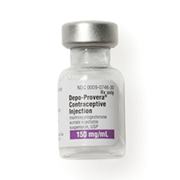Using a method of birth control with estrogen, like the pill, patch, or ring, increases the risk of forming a blood clot, but the risk is so low that if you don’t have any factors that increase your chances of having a blood clot, you can safely use all types of birth control. If you do have an increased risk of blood clots because you’ve had one before you’ve had a stroke or heart attack, or you have a medical condition that increases your risk of a blood clot, like high blood pressure, then adding birth control with estrogen to the mix increases your risk too much and it’s not recommended that you use birth control with estrogen in it. But that doesn’t mean there isn’t a birth control method for you!
If you can’t take estrogen, you have quite a few options available to you. First you have the non-hormonal methods, like the copper IUD. You can also use any of the hormonal methods that only contain progestin, not estrogen, like the implant, mini-pill, shot, and hormonal IUDs, like Mirena, Skyla, Liletta, and Kyleena. These don’t increase your risk of blood clots and are all really good at preventing pregnancy.
If you’re worried about blood clots or don’t know if you have risk factors, talk to a health care provider about which birth control methods are options for you.
Using a method of birth control with estrogen, like the pill, patch, or ring, increases the risk of forming a blood clot, but the risk is so low that if you don’t have any factors that increase your chances of having a blood clot, you can safely use all types of birth control. If you do have an increased risk of blood clots because you’ve had one before you’ve had a stroke or heart attack, or you have a medical condition that increases your risk of a blood clot, like high blood pressure, then adding birth control with estrogen to the mix increases your risk too much and it’s not recommended that you use birth control with estrogen in it. But that doesn’t mean there isn’t a birth control method for you!
If you can’t take estrogen, you have quite a few options available to you. First you have the non-hormonal methods, like the copper IUD. You can also use any of the hormonal methods that only contain progestin, not estrogen, like the implant, mini-pill, shot, and hormonal IUDs, like Mirena, Skyla, Liletta, and Kyleena. These don’t increase your risk of blood clots and are all really good at preventing pregnancy.
If you’re worried about blood clots or don’t know if you have risk factors, talk to a health care provider about which birth control methods are options for you.

